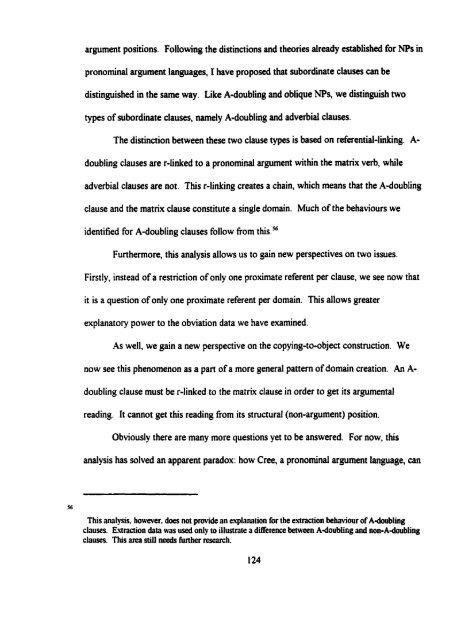Adverbial and Argument-Doubling Clauses in Cree - MSpace
Adverbial and Argument-Doubling Clauses in Cree - MSpace
Adverbial and Argument-Doubling Clauses in Cree - MSpace
Create successful ePaper yourself
Turn your PDF publications into a flip-book with our unique Google optimized e-Paper software.
argument positions. Foiiow<strong>in</strong>g the dist<strong>in</strong>ctions <strong>and</strong> theories already established for NPs <strong>in</strong><br />
pronom<strong>in</strong>al argument languages, I have proposed that subord<strong>in</strong>ate clauses can be<br />
dist<strong>in</strong>guished <strong>in</strong> the same way. Like A-doubl<strong>in</strong>g <strong>and</strong> oblique NPs, we dist<strong>in</strong>guish two<br />
types of subordhate clauses, namely A-doubi<strong>in</strong>g <strong>and</strong> adverbial clauses.<br />
The dist<strong>in</strong>ction between these two clause types is based on referential-l<strong>in</strong>k<strong>in</strong>g. A-<br />
doubl<strong>in</strong>g clauses are r-l<strong>in</strong>ked to a pronom<strong>in</strong>al argument with<strong>in</strong> the matrix verb, while<br />
adverbial ciauses are not. This r-l<strong>in</strong>k<strong>in</strong>g creates a cha<strong>in</strong>. which means that the A-doubl<strong>in</strong>g<br />
clause <strong>and</strong> the matrix clause constitute a s<strong>in</strong>gle doma<strong>in</strong>. Much of the behaviours we<br />
identified for A-doubl<strong>in</strong>g clauses follow from thi~.'~<br />
Furthemore, this analysis allows us to ga<strong>in</strong> new perspectives on two issues.<br />
Firstly, <strong>in</strong>stead of a restriction of only one proximate referent per clause, we see now that<br />
it is a question of only one proximate referent per doma<strong>in</strong>. This allows greater<br />
explanatory power to the obviation data we have exam<strong>in</strong>ed.<br />
As well, we ga<strong>in</strong> a new perspective on the copy<strong>in</strong>g-to-object construction. We<br />
now see this phenornenon as a pan of a more general pattern of doma<strong>in</strong> creation. An A<br />
doubl<strong>in</strong>g clause must be r-l<strong>in</strong>ked to the marrix clause <strong>in</strong> order to get its argumental<br />
read<strong>in</strong>g. It cannot get this read<strong>in</strong>g from its structural (non-argument) position.<br />
Obviously there are many more questions yet to be answered. For now, this<br />
analysis has solved an apparent paradox: how <strong>Cree</strong>, a pronom<strong>in</strong>al argument language, can<br />
This analysis, however, does not provide an explanation for the e.mction behaviour of A-doubl<strong>in</strong>g<br />
clauses. Extraction data was used only to illustrate a difference berneen Adoubl<strong>in</strong>g <strong>and</strong> non-Adoubl<strong>in</strong>g<br />
clauses. This area still needs h<strong>in</strong>her resexch.








![an unusual bacterial isolate from in partial fulf]lment for the ... - MSpace](https://img.yumpu.com/21942008/1/190x245/an-unusual-bacterial-isolate-from-in-partial-fulflment-for-the-mspace.jpg?quality=85)




![in partial fulfil]ment of the - MSpace - University of Manitoba](https://img.yumpu.com/21941988/1/190x245/in-partial-fulfilment-of-the-mspace-university-of-manitoba.jpg?quality=85)


